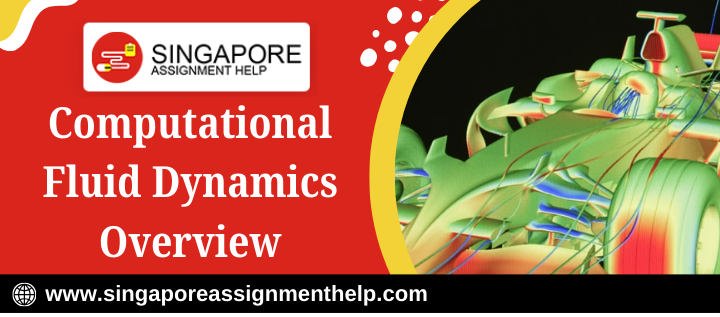Computational Fluid Dynamics Overview
Computational fluid dynamics is a branch of engineering that deals with the study and application of numerical analysis to predict the flow of gas or liquid through channels, around objects, and past surfaces. It has many applications in many different industries including aeronautical engineering, medicine, physics, bioengineering, and more for Singapore university and college. This blog post is on computational fluid dynamics. We will explore what computational fluid dynamics is as well as how it can be used to solve problems in various different fields.

What is the meaning of computational fluid dynamics?
In Singapore Computational Fluid Dynamics (CFD) is a branch of fluid mechanics that uses numeric analysis and computer simulation to predict the behavior of multi-phase, turbulent fluid flow. It takes into account the physical laws governing fluids under different conditions, such as compressibility, phase change, and other effects.
CFD provides accurate information about how air flows over objects like buildings or cars which cannot be obtained by experiment or by simpler methods designed for laminar flow, e.g., LES (Large Eddy Simulation).
Read also: Get free essay samples
When did computational fluid dynamics start?
They certainly existed before the 1990s, but most people looking for a solid answer on when computational fluid dynamics start typically start in the 1990s.
Today’s CFD has been enhanced by advancements in high-speed computers and powerful software to solve complex engineering problems that were once prohibitively expensive or too time-consuming to undertake.
In recent years, many new applications have been developed for CFDs in aerospace, automotive design, and development, structural health monitoring, including vibration analysis, process design and optimization, mining simulations, and combustion modeling for optimized power plant designs in Singapore. The increased power of today’s PCs is used to increase accuracy with less computing time than older machines required.
Hire a Professional Essay & Assignment Writer for completing your Academic Assessments
Native Singapore Writers Team
- 100% Plagiarism-Free Essay
- Highest Satisfaction Rate
- Free Revision
- On-Time Delivery
Importance of computational fluid dynamics
Computational fluid dynamics (CFD) is an area of study in fluid mechanics that uses complex mathematical and computational modeling to simulate the natural movement of fluids. It combines knowledge from engineering, physics, and mathematics to analyze how air and liquids move around objects.
Computer models can be used either to simulate events that could not occur outside a computer – such as high-speed flows or impacts by air-bombs- or provide results for design optimization before ever building a prototype in Singapore. The main advantage CFD has over experiments is economic: while it might cost millions of dollars to conduct some flow measurements in real life, it only costs several minutes’ time on a typical desktop computer that can be shared among many users.
Three main stages of a computational fluid dynamics simulation process
In the computational fluid dynamics blog, three main stages of this process are:
- Mesh generation
- Computation
- Data post-processing
Mesh generation uses geometric modeling to represent the domain of analysis as three-dimensional triangular cells with interconnecting nodes, properly distributed in space according to the streamlines of fluid flow involved during computation. The resulting mesh reduces computational costs but is an important part of simulation accuracy because many physical phenomena are not confined to a bounded volume but rather extend outward through free surfaces into unbounded domains, three dimensions in space.
Computation takes place on each cell or node using one or more numerical algorithms that determine spatial changes at that point by integrating differential equations governing the underlying fluid flow over time steps which are usually small fractions – often just 10E-6 – of a second. The results are then stored for later use, or they can be used immediately if the user intends to do a visual inspection as part of the post-processing stage.
Data post-processing is required because the information from each individual cell cannot produce useful insights into overall flow patterns and phenomena such as turbulence that occur on scales larger than single cells in space which may have dimensions measuring hundreds of micrometers across when fluid flows past solid objects like aircraft wings (computational mesh resolution has to be accurate enough).
This requires specialized visualization techniques where data from all cells are integrated together according to their locations in space and time so that trends and features important at one scale become visible also at other scales relevant physical interpretation.
How do you analyze CFD?
For Singaporean students to the analysis of CFD is usually carried out in the following four steps:
Step 1: Preliminary information processing and turbulence modeling.
Step 2: Computational grid generation.
Step 3: Calculating spatial derivatives for determining fluxes and boundary conditions.
Step 4a: Moving Primitive Mesh (the mesh should be relatively coarse) – first calculation cycle.
Step 4b: Wavelet Mesh (the mesh should be fine) second calculation cycle, to reinforce directional dependence. This step can be carried out as many times as needed to obtain a convergent result. Ideally, it should take one or two cycles before convergence is achieved. In this way, it will take far less time than using a unidirectional mesh.
The method is used in CFD to Analyse the fluid dynamics
For Singapore university and college courses, a method is used in CFD to analyze the fluid dynamics is:
A computer simulation technique for solving complicated mathematical tasks. The technique can be used to investigate problems too difficult or expensive to solve with pencil-and-paper techniques, or where it is not feasible or easy enough to test an idea by building a physical system.
The process of virtual prototyping allows the exploration of designs and behaviors without having anything built. This can speed up developmental cycles tremendously.
For example, using 3D “modeling” software, one can build complex simulations that are predicted with accuracy; these could then be tested before they’re actually built!
Computational Fluid Dynamics Software
In this computational fluid dynamics article, students get knowledge of software like SimScale’s Computational Fluid Dynamics Software is a powerful, scalable, and easy-to-use simulation software for engineers’ design work on aerospace, automotive products, and other engineering projects.
Simply put, it can help designers of all levels create real insight into the implications of their designs with 3D simulations which are accurate down to microns. The modularity of this platform means that new modules can be added as your needs grow from advanced CFD through FEA to meshing and others. With SimScale you have one single solution for aerodynamics, propulsions systems, or multidisciplinary studies without any need to contact a range of experts for help.
Buy high-quality essays & assignment writing as per particular university, high school or college by Singapore Writers
Benefits of Computational Fluid dynamics
Computational Fluid dynamics is the branch of continuum mechanics that deals with simulating aerodynamics or hydrodynamics in Singapore. The method goes by several names, including computational fluid dynamics (CFD), computational aerodynamics, wind/water tunnels for computer simulations, etc.
This simulation is necessary because real-world testing at 192-foot wingspans would be impossible. That’s too big to park outside an office building!
Benefits are numerous in nature! Apart from simplifying computationally heavy problems associated with the fluid flow without approximations that lead to errors, CFD also improves accessibility to test complex scenarios under controlled parameters. But this isn’t all it can do!
For instance, CFD analysis also shows instantaneous changes in fluid flows in a virtual environment. These changes can be analyzed and used to control the flow of fluid through an object (or vice versa).
Computational Fluid Dynamics Applications
Computational fluid dynamics (CFD) is a branch of fluid mechanics that uses mathematical equations and algorithms to understand how air and water flow.
The phenomena modeled by CFD are diverse. Applications include for example Wall turbulence or Wind Turbine design.
CFD uses a computer to solve the governing equations of a physical system that owns mass, energy, momentum, and sometimes space as well as time scales. It does so by discrediting the problem (applying finite elements across all domains). The solution iteratively builds on past computational work in ever-smaller incremental steps until there is an agreement with experimentally observed results at given time steps.
Get affordable Assignment writing service at Singapore assignment help
If you want cheap and efficient help with your essay or research paper, Assignment help Singapore is the way to go. They have a team of expert writers that can provide any assistance for anything! Don’t worry about rates because they are affordable enough even without compromising their quality work.
Get quick and instant help with online exam, essay writing service as well as a report writing service from this amazing site!
We have a team of expert writers that will provide assistance at any level whether it is an essay or research paper as well as essay writing services. You just require to write my essay for me service.
So if you are looking to hire online exam helpers in Singapore then we would love to work with you today!











